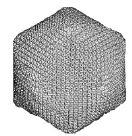Plant Pathology, Department of

James Van Etten Publications
Document Type
Article
Date of this Version
2006
Citation
Published in final edited form as: Adv Virus Res. 2006 ; 66: 293–336.
- DOI: 10.1016/S0065-3527(06)66006-5
PMCID: PMC1955756
Abstract
Chlorella viruses or chloroviruses are large, icosahedral, plaque‐forming, double‐stranded‐DNA— containing viruses that replicate in certain strains of the unicellular green alga Chlorella. DNA sequence analysis of the 330‐kbp genome of Paramecium bursaria chlorella virus 1 (PBCV‐1), the prototype of this virus family (Phycodnaviridae), predict ∼366 protein‐encoding genes and 11 tRNA genes. The predicted gene products of ∼50% of these genes resemble proteins of known function, including many that are completely unexpected for a virus. In addition, the chlorella viruses have several features and encode many gene products that distinguish them from most viruses. These products include: (1) multiple DNA methyltransferases and DNA site‐specific endonucleases, (2) the enzymes required to glycosylate their proteins and synthesize polysaccharides such as hyaluronan and chitin, (3) a virus‐encoded K+ channel (called Kcv) located in the internal membrane of the virions, (4) a SET domain containing protein (referred to as vSET) that dimethylates Lys27 in histone 3, and (5) PBCV‐1 has three types of introns; a self‐splicing intron, a spliceosomal processed intron, and a small tRNA intron. Accumulating evidence indicates that the chlorella viruses have a very long evolutionary history. This review mainly deals with research on the virion structure, genome rearrangements, gene expression, cell wall degradation, polysaccharide synthesis, and evolution of PBCV‐1 as well as other related viruses.


Comments
Published by Elsevier. Used by permission.